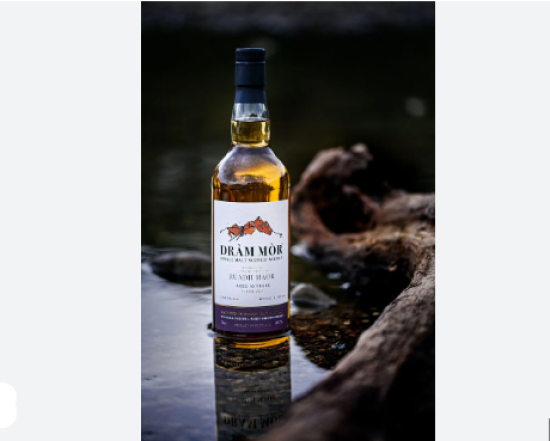Chicken Cock Rye Whiskey
A friend recently gifted me a bottle of Chicken Cock Rye Whiskey. I’ve enjoyed their bourbon; will their rye whiskey win me over, too?…
A friend recently gifted me a bottle of Chicken Cock Rye Whiskey. I’ve enjoyed their bourbon; will their rye whiskey win me over, too?…
Benrinnes 23 yo 1962/1986 (46%, Cadenhead ‘Original Collection’)Benrinnes 25 yo 1971/1997 (46.9%, Cadenhead Authentic Collection, sherrywood matured)

Independent Turkish bottler KA Icecek is expanding its whisky portfolio with the recent release of a new limited edition whisky series. The series, The Project W, consists of no-age-statement whiskies bottled from distilleries around Scotland. KA Icecek has also added new staffing to procure the expressions. As the first independent bottling project in Turkey, Project W […]
The post Turkish Bottler KA Icecek Debuts The Project W Whisky Series first appeared on Whisky Critic – Whisky Reviews & Articles – Style. Attitude. Whisky..

Angel’s Envy is continuing to spread its wings with an announcement of its distillery expansion plans for 2024. The acclaimed brand broke ground in 2013 as it hasn’t slowed down since. In 2023, Angel’s Envy unveiled an impressive $8.2 million distillery expansion including 5 tasting rooms, gorgeous events space, new kitchen, and showcase bar. 2024 […]
The post Angel’s Envy Distillery Plans For 2024 Campus Expansion in Downtown Louisville first appeared on The Bourbon Review.

Louisville’s Bourbon star has been on the continual rise, adding new distilleries and experiences year over year. Now, the “Bourbon City” welcomes with open arms its newest amber experience member – Pursuit Spirits. The innovative whiskey company behind the popular Pursuit United line of bourbons and ryes, is thrilled to announce the launch of two […]
The post Louisville’s Newest Whiskey Experience from Bourbon Pursuit Founders is Calling Your Name first appeared on The Bourbon Review.

Molson Coors-owned Blue Moon Brewing is promoting their Blue Moon Non-Alcoholic Belgian White — which debuted in December 2023 — for those abstaining from alcohol for the so-called Dry January but intending to reset in February 2024. Beginning on January 12, 2024, for every six pack of Blue Moon Non-Alcoholic Belgian White that consumers purchase […]
The post Blue Moon Promotes New Dry-Back January Non-Alcoholic Beer first appeared on Whisky Critic – Whisky Reviews & Articles – Style. Attitude. Whisky..

Drum roll…ladies and gentlemen, the #1 2023 Best Selling American Whiskey Brand per Drinks International (DI) is…Maaaaker’s Maaaark! What does that mean? By volume? Certain price point? Geo parameters? We shall elaborate on the selection process and how it’s done. What Goes Into Drinks International (DI) Ranking System? Each year (est. 2015), DI releases an annual report on the […]
The post Top 10 Best Selling American Whiskey Brands of 2023 by “Drinks International” first appeared on The Bourbon Review.
Foreword: While in past posts I have dealt with “whiskey men” who engaged in multiple marriages, those stories frequently involved the death of a spouse and remarriages. [See post of May 14, 2019.] In other instances whiskey men have been involved in marriages that ended in divorces that were “messy” or involved “high society,” some meriting newspaper headlines. The four short narratives that follow demonstrate a range of circumstances surrounding the breaking of marriage bonds. Note that in each case it was the wife who sued for divorce.
 George Buente: Booze for Indians, Blows for Wife. Buente was the owner of a St. Louis shipping company whose principal trade was illicitly selling whiskey on Indian reservations. Having outraged officials involved in Native American affairs, he ultimately became the government’s “poster boy” for the greed of American citizens prospering from the sale of “firewater.” In St. Louis Buente made other headlines for wife beating.
George Buente: Booze for Indians, Blows for Wife. Buente was the owner of a St. Louis shipping company whose principal trade was illicitly selling whiskey on Indian reservations. Having outraged officials involved in Native American affairs, he ultimately became the government’s “poster boy” for the greed of American citizens prospering from the sale of “firewater.” In St. Louis Buente made other headlines for wife beating.
In 1874 Buente returned to his native Prussia where he found a bride in 26-year-old Augusta, a women eleven years his junior, and brought her back to the U.S. In quick succession they had three children. A clue to Buente’s character may be Augusta’s petition for divorce in 1881 after seven years of marriage. During the three preceding years, according to her testimony, her husband whipped and maltreated her on many occasions, beating her with his fists, throwing her violently against the wall and striking her while she was pregnant.
Augusta further alleged that Buente frequently taunted her with a description of his illicit amours. Her divorce petition stated: “She bore this treatment until it became intolerable, and was at length compelled to appeal to the court for relief.” Augusta sought custody of their children and considerable alimony, noting Buente’s lucrative business and real estate holdings. The judge agreed, granted her the divorce, child custody and alimony.
 Buente fared no better in a second court appearance. Having been caught shipping liquor into Indian Territory, Buente was arrested and brought before a federal court. He feigned ignorance of the law but nonetheless pled guilty to the charges. He was fined $500 (equivalent to more than $12,000 today) and court costs. Whether this conviction was enough to discourage him from sending liquor again into Indian Territory is unclear.
Buente fared no better in a second court appearance. Having been caught shipping liquor into Indian Territory, Buente was arrested and brought before a federal court. He feigned ignorance of the law but nonetheless pled guilty to the charges. He was fined $500 (equivalent to more than $12,000 today) and court costs. Whether this conviction was enough to discourage him from sending liquor again into Indian Territory is unclear.

While still in his 20s Philpot established liquor stores in two small Michigan cities: Port Huron, located in the northeastern most part of the state on Lake Huron, and Adrian, 130 miles south, not far from the Ohio border. On the outskirts of Adrian Philpot bought a 20 acre spread on which he raised prize poultry. A biographer noted: “He is a great fancier of finely bred chickens, and his pens…have won many prizes at different fairs and poultry shows where they have been exhibited.”
 In June of 1890 Philpot married 22-year old Gertrude Durham of Romeo, Michigan, and settled her on the farm. There would be no children. Leaving Gertrude miles away in Adrian to feed and nurture his chickens, Philpot spent the bulk of his time in Port Huron expanding his liquor trade there. His rapt attention to business may have been explained by a local news report: “A large number of people are employed…In the labeling department a number of girls find employment.” After nine years of doling out feed to Philpots’ leghorns, houdans, and brahmas, Gertrude called it quits. Charging him with “extreme cruelty” she obtained a divorce.
In June of 1890 Philpot married 22-year old Gertrude Durham of Romeo, Michigan, and settled her on the farm. There would be no children. Leaving Gertrude miles away in Adrian to feed and nurture his chickens, Philpot spent the bulk of his time in Port Huron expanding his liquor trade there. His rapt attention to business may have been explained by a local news report: “A large number of people are employed…In the labeling department a number of girls find employment.” After nine years of doling out feed to Philpots’ leghorns, houdans, and brahmas, Gertrude called it quits. Charging him with “extreme cruelty” she obtained a divorce.
Philpott wasted little time in remarrying, having a child, buying a large Port Huron home, and settling there. When Michigan went “dry” in 1917, he began to deal in foreign securities, including Russian Imperial bonds, above, issued before the Communist Revolution. According to press accounts: “Philpott is said to have disposed of virtually worthless Russian bonds to Michigan investors at a considerable loss to the latter.” By 1929, the Michigan Securities Commission in Lansing had had enough. The Commission revoked his brokerage license. A year later Philpot after a brief illness died in Port Huron, age 58.
Fred Hipsh: The Con Man Cuckolded. Fred Hipsh was a Hungarian immigrant who spent much of his working life in New York City acting as a “distiller’s agent” representing whiskey distillers and rectifiers, selling client alcoholic products, and conducting tastings and other promotional events. But Hipsh had abent toward chicanery, claiming to own a non-existent Kentucky distillery and selling fraudulent bond certificates for whiskey allegedly being aged in a non-existing warehouse.

 While Hipsh was cheating in the whiskey trade and getting away with it, his wife, Anna, was cheating on their marriage. Fourteen years younger than Hipsh, Anna was attractive and was working as a stenographer when the couple married. Now her lover was Theodore P. Shonts, one of New York’s richest and most powerful men as president of a New York Interborough Transit Company and an officer in several large railroads. Hipsh sued Shonts for $200,000, (more than $4 million today) for “alienation of affections.” Known to be in an unhappy marriage, Shonts, shown here, lamely claimed Hipsh’s charges were a case of mistaken identity and that the real culprit was his “double.”
While Hipsh was cheating in the whiskey trade and getting away with it, his wife, Anna, was cheating on their marriage. Fourteen years younger than Hipsh, Anna was attractive and was working as a stenographer when the couple married. Now her lover was Theodore P. Shonts, one of New York’s richest and most powerful men as president of a New York Interborough Transit Company and an officer in several large railroads. Hipsh sued Shonts for $200,000, (more than $4 million today) for “alienation of affections.” Known to be in an unhappy marriage, Shonts, shown here, lamely claimed Hipsh’s charges were a case of mistaken identity and that the real culprit was his “double.”
When Hipsh confronted Anna with solid evidence of the adultery, she packed a suitcase and bolted for the train station. When the New York press caught up with her, Anna was in Reno, Nevada, apparently there for a “quicky” divorce. Possibly with Shonts’ assistance, she was staying at the posh Riverside Hotel. Anna acknowledged to reporters that she knew Shonts, saying: “He has always treated me as a gentleman should treat a woman.” But she denied they were having an affair.
Subsequently Fred and Anna divorced, a settlement was reached with Shonts, and the railroad magnet, who clearly had a roving eye, went on to other women and scandals. Hipsh, now single, moved to New York’s Marseilles Hotel. His days in court were not over, convicted in 1913 of welshing on a large debt. Hipsh died the same year. Anna’s fate is unknown.
 Augustus Goodwin: Rich, But Wife Yearned for Royalty. Goodwin was a wealthy Boston merchant, CEO of a chain of specialty grocery stores that featured at least thirteen brands of his proprietary whiskeys. Despite his success, Augustus found his New York socialite wife enamored of European royalty to the point of dumping him for a hereditary count. Shown here is Frances Thorley Goodwin, subsequently known widely to New York society as “Countess von der Palen-Kar,” a designation as questionable as the origins of her second husband’s title.
Augustus Goodwin: Rich, But Wife Yearned for Royalty. Goodwin was a wealthy Boston merchant, CEO of a chain of specialty grocery stores that featured at least thirteen brands of his proprietary whiskeys. Despite his success, Augustus found his New York socialite wife enamored of European royalty to the point of dumping him for a hereditary count. Shown here is Frances Thorley Goodwin, subsequently known widely to New York society as “Countess von der Palen-Kar,” a designation as questionable as the origins of her second husband’s title.
 Goodwin attempted to keep Frances content by agreeing to a major remodeling of their mansion home at 130 Commonwealth Avenue, in one of Boston’s most elegant neighborhoods. (In 2015 the house sold for $11.6 million.) Despite her husband’s exertions Frances was not satisfied. She had developed a yen for royalty in the person of Count Adolphe J. von der Palen-Klar, living in Brooklyn, likely under modest circumstances. Adolphe’s family is said to have achieved nobility in 1799 when Emperor Paul the First of Russia, for reasons unknown, gave Peter Ludwig von der Pahlen and all of his descendants the rank of count. The family coat of arms was something of a jumble.
Goodwin attempted to keep Frances content by agreeing to a major remodeling of their mansion home at 130 Commonwealth Avenue, in one of Boston’s most elegant neighborhoods. (In 2015 the house sold for $11.6 million.) Despite her husband’s exertions Frances was not satisfied. She had developed a yen for royalty in the person of Count Adolphe J. von der Palen-Klar, living in Brooklyn, likely under modest circumstances. Adolphe’s family is said to have achieved nobility in 1799 when Emperor Paul the First of Russia, for reasons unknown, gave Peter Ludwig von der Pahlen and all of his descendants the rank of count. The family coat of arms was something of a jumble.
How Adolphe got to Brooklyn and what he did there mattered little to Frances who had enough family money for them both. She divorced Augustus and married the Count in November 1927 at the American Church in Paris. After a honeymoon they returned to live in New York. Frances quickly appropriated the title of “countess,” however murky its origins. Adolphe moved out of Brooklyn for lodgings with his new wife at one of upper Manhattan’s swankiest addresses, 920 Fifth Avenue, also home to movie star Gloria Swanson. The New York press paid close attention to the social whirl of Count and Countess von der Palen-Klar. Clothed in royalty, Frances Thorley had arrived at the pinnacle of Gotham’s social set.
Meanwhile back in Boston, Augustus Goodwin, remarried, was busy running his businesses and indulging his hobby as an owner/breeder of thoroughbred racehorses. Goodwin’s love for horses was his undoing. In July 1934, he dressed in his riding outfit and drove to the nearby stables where he kept his steeds, mounted one and rode off. Somewhere along his journey the horse threw him to the ground. Goodwin may have died almost instantly. The cause was recorded as “fracture at base of skull.” Countess Frances died in 1944 in New York. The Count followed four years later.
Note: More complete stories of each of these “whiskey men” may be found elsewhere on this website: George Buente, January 21, 2018; J. G. Philpott, December 21, 2022; Fred Hipsh, April 3, 2019, and Augustus Goodwin, August 9, 2021.
For many years, I have been saying American Single Malt Whiskey was not worth the money. American distilleries were trying too hard to imitate Scotch Whisky by smoking their malt with peat and it was mediocre single malt at best…. Continue Reading &#…
Armorik 16 yo 2006/2023 (60.5%, The Auld Alliance, Sauternes cask, cask #8003)Goalong Single Malt Whiskey 5 yo (40%, OB, China, bourbon, +/-2023)Abasolo (43%, OB, Mexico, maize whisky, +/-2023)Goldwaescher Swiss Rye 5 yo 2018/2023 (53.5%, OB, Switzerla…